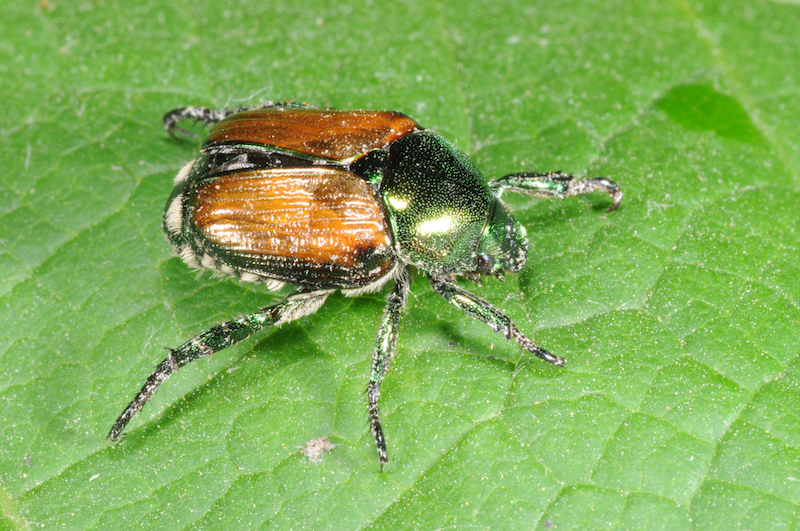Japanese Beetle, Vol. 8, No. 15
Popillia japonica
Order: Coleoptera
Family: Scarabaeidae
Japanese beetles (JB) have been in the country more than 100 years, having first been detected in New Jersey around 1916. Since then, they have colonized the northeastern US and are considered major pests of roses, Japanese maples, crape myrtles, grapes, plums, crab apples, and hundreds of other ornamentals. They also damage vegetables such as beans and sweet corn. Although these little green beetles are well-established in Northern Alabama and Georgia, much of Mississippi remains relatively free of JB. But over the past decade or so, Japanese beetles have become significant, recurring pests in many north Mississippi counties.
The larvae are typical C-shaped white grubs and are difficult to distinguish from other white grubs without close examination. JB grubs damage turfgrass, but in most Mississippi landscapes, it is the adults and not the grubs that cause the most problems. Adults are strong flyers and can invade from distant breeding sites. You don’t necessarily have to grow your own.
Adult Japanese beetles are easy to identify. They are a little over ½ inch long and their metallic green and bronze colors are distinctive. But there are a few other green or bronze beetles that are sometimes mistaken for JB. These include Green June Beetle and Rainbow Scarab Dung Beetles. To be sure you are looking at a Japanese beetle and not some other “look alike,” notice the wings. The wings of JBs are notably shorter than the body, and there will be tufts of white hairs protruding from the body, just below the margin of the wings (see photo).
Adult JB damage plants by feeding on the leaves, leaving many of the leaf veins intact, resulting in a skeletonized appearance. Heavily damaged leaves resemble a brown, leaf-shaped lace doily. They also feed on blooms of roses and other plants, reducing their aesthetic value, and damage corn by cutting the silks and preventing or reducing pollination.
Control: Adult Japanese beetles are difficult to control. If you have susceptible plants in a landscape where JBs are present, they are going to sustain some damage. Fortunately, low levels of defoliation are rarely harmful to the overall health of the plant. But even low levels of leaf or bloom feeding can cause unsightly damage.
Foliar sprays of pyrethroid insecticides such as permethrin, bifenthrin, or cyfluthrin will kill beetles that are directly sprayed and provide some residual control, but multiple sprays are usually required due to continued reinfestation. Preventively treating susceptible plants with soil-applied treatments of imidacloprid before the JB flight begins can also reduce injury. As an organic option, insecticide products containing azadirachtin or neem oil are repellent to JB and can be used preventively.
What about traps? JB traps baited with pheromones or attractants can attract and capture thousands of beetles, but they attract more beetles than they catch, and plants located near JB traps usually end up with more damage. If you use traps, place them far away from susceptible plants.
For more information on management and control of Japanese beetles see page 28 of Extension Publication 2369, Insect Pests in and around the home landscape.
See page 6 of Extension Publication 2331, Control Insect Pests in and around the Home Lawn for information on white grub control. Recommended treatments will control JB grubs as well as other species of white grubs.
Blake Layton, Extension Entomology Specialist, Mississippi State University Extension Service.
The information given here is for educational purposes only. Always read and follow current label directions. Specific commercial products are mentioned as examples only and reference to specific products or trade names is made with the understanding that no discrimination is intended to other products that may also be suitable and appropriately labeled.
Mississippi State University is an equal opportunity institution.
Bug’s Eye View is now on Facebook. Join the Bug's Eye View Facebook group here.


